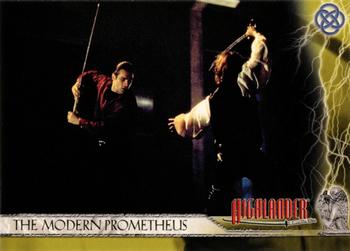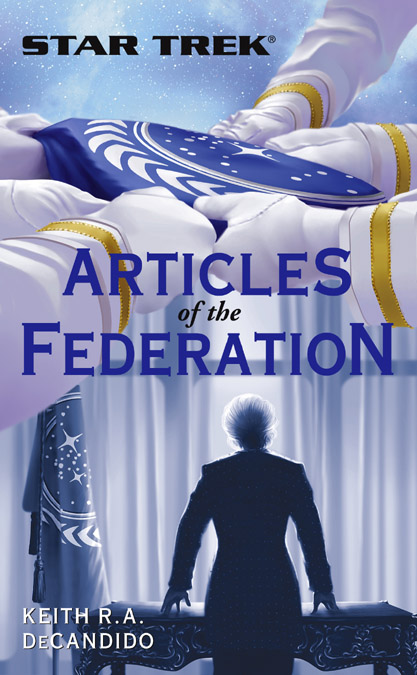Back in the 1990s, I was part of a mailing list of fans of Highlander: The Series, the syndicated drama starring Adrian Paul that spun off of the film Highlander and its sequels starring Christopher Lambert. I actually liked the TV show much more than the films, and during a break between episodes in March 1997, I decided to review all the episodes to date on that list, which was called HIGHLA-L.
The reviews were well received by the list, and I continued to review new episodes as they came out. Later on, I archived them on my web site, hosted by SFF.net. Eventually, I may put all the reviews up, but that’s a lot for a two-decade-old series.
However, there was one episode I singled out for a much lengthier review: “The Modern Prometheus,” a fifth-season episode that posited Lord Byron as an Immortal, and included a lengthy flashback to the famous gathering that included Byron, Percy Bysshe Shelley, Mary Shelley, and Dr. John Polidori, though instead of Polidori, Byron’s physician is Methos, using the name Dr. Adams.
As a huge fan of the Romantics and of the Shelleys and Byron, I was very curious about the episode — and I had significant thoughts on it after it aired, few of which were favorable.
In honor of the review I just did for Tor.com of the new Mary Shelley movie, in which I make a passing mention of the Highlander episode, I present my thoughts from back in 1997 about “The Modern Prometheus.”

This stunk as a Highlander episode, stunk as a treatment of modern musicians, and really stunk as a portrayal of one of the most famous (and best documented) literary gatherings since Bill Shakespeare and Kit Marlowe met for beers at their local in Stratford-upon-Avon.
Let’s start with the less specialized portions of the story, to wit, Duncan, Byron, Joe, and Mike-the-guitarist. What Byron did in the teaser was reprehensible (though the guy was an idiot, but that doesn’t mean he deserved to die). The man was a hero-worshipping loon, and Byron took advantage of that. But nobody else in the story knew about their attempt at an Icarus-and-Daedalus ripoff, so it’s not really relevant to how the other characters reacted to Byron, only to the viewer’s reaction.
What Byron did to Mike was give him drugs — my God, man, a musician taking drugs! What is this world coming to!?!? And he died, not of a great fall he was talked into while plastered, but of an overdose, which falls into the self-inflicted category. Admittedly, Byron put temptation in Mike’s path, but Mike’s a big boy — unlike the schlump in the teaser (who was caught up in the moment), Mike had plenty of opportunities to walk away, and he chose to come back. To use Duncan’s analogy, Byron didn’t pull the trigger, but he didn’t hand Mike the gun, either, he just left the gun on the table and told him it was there.
Other problems: if Byron is a major rock star, why doesn’t he have any security to speak of? A drooling fangeek walks right up to him and asks if he’s listened to his demo tape in the teaser. Duncan and Methos just wander into his apartment without any kind of clearance; Duncan does the same later on by himself. You can argue that Byron had cleared Methos as an old friend earlier, but there’s no way they’d let Duncan in by himself, especially when Byron wasn’t home. And then Duncan manages to get backstage prior to the concert, and is allowed to stay throughout the show. I mean, c’mon, heads of state don’t always get the same level of security as rock stars. And amazing how there are no consequences to a major rock star being found beheaded shortly after he went off alone with Duncan MacLeod, huh?
In the rehearsal scene when Joe told Mike to go get some sleep — I’m confused, what was the problem there? Mike was in tune, playing along just fine, he was with the rhythm, playing leads — why did Joe cut him off? He didn’t look stoned, he didn’t look any more or less out of it than he did in his first scene in Maurice’s club. There was no reason shown on screen why Joe should kick Mike out. The camera showed looks of disappointment on Duncan and Joe’s faces, but I heard nothing in the music being played to warrant that. Mike was playing just as well as he had in the first scene at the club.
And therein lies one of the (many) problems with the episode — telling rather than showing. The only good scene in the whole damn thing was the last meeting between Byron and Methos, where we finally get a sense of the emptiness Byron feels. (“I have no poetry left!” he cries, and we believe him based on the dopey lyrics in the teaser.) That scene also has the prototypical Methos line, in response to Byron’s query as to what he wants on his tombstone: “You’re not listening, I don’t want a tombstone.”
But that’s the only evidence we get of that transformation, because Byron as portrayed in 1816 is exactly the same as Byron in 1997. He’s a drunken, fornicating baboon in Switzerland and he’s a drunken, suicidal baboon in Paris. “You used to reach for heaven,” Methos says in 1997, but in 1816, the only thing Byron reaches for is womanly flesh and another drink.
* * *
But then again, this is what happens when the writer’s idea of researching the lives of the Romantic authors is to rent Gothic. While the summer spent at the Villa Diodati in 1816 was not the genteel drawing-room scenario portrayed in the prologue to the movie Bride of Frankenstein, nor was it the Caligula-style orgy witnessed both in Gothic and this episode.
Herewith, an excerpt from Byron’s 1816 journal, as printed in Byron: A Self Portrait, edited by Peter Quennell:
Sept. 17th
Rose at five; left Diodati about seven, in one of the country carriages (a Charaban), our servants on horseback: weather very fine; the Lake calm and clear; Mont Blanc and the Aiguille of Argentieres both very distinct; the borders of the Lake beautiful. Reached Lausanne before Sunset; stopped and slept at Ouchy.
H[obhouse] went to dine with a Mr. Okeden. I remained at our Caravansera (though invited to the house of H.’s friend–too lazy or tired, or something else, to go), and wrote a letter to Augusta [his sister]. Went to bed at nine–sheets damp: swore and stripped them off and flung them–Heaven knows where: wrapt myself up in the blankets, and slept like a child of a month’s existence till 5 o’Clock.
Most of the other entries, which cover the last two weeks in September (by this point, Percy and Mary had departed Switzerland and returned to England), are of much the same tenor. Kinda disappointing, innit? He was also working on Childe Harold’s Pilgrimage, one of his greatest works. Oh, and the to-bed-at-nine-up-at-five routine was fairly typical. The man didn’t sleep a helluva lot.
Did Lord Byron sleep around? Yes, constantly. Was he adored by women? Oh, yes. Did he have health problems that led to his taking all kinds of interesting medication that are not legal in the modern U.S.? Yes. Did he drink way too much? Yes. But he was also a charming, intelligent, witty man, who cared for his friends (he was very helpful to Mary Shelley in the years after Percy Shelley’s death, when she was suffering serious financial crises due to the disapproval of Shelley’s family of their entire relationship). Though what we get in this episode is certainly an aspect of Byron’s personality, it isn’t even close to all of it. The thing that so many fictional portrayals of Byron miss out on (with the notable exception of the fiction of Tim Powers) is the man’s sense of humor. The man who wrote the letters he wrote, the man who wrote “Vision of Judgment” (a hilarious satire of poet laureate Robert Southey’s elegy to George III of the same title) was a man who was a hoot and a holler.
* * *
This leads nicely to the major problem with this episode. It’s the same problem “Take Back the Night” had in its second flashback when it posited that Flora MacDonald was really the Immortal Ceirdwyn. Flora’s life (including her growing older) was very well documented, but not nearly as well as the lives of Lord Byron, Percy Bysshe Shelley, Mary Wollstonecraft Godwin Shelley, Claire Clairmont, and Dr. John Polidori. Yes, I know what you’re thinking: “Claire who? And don’t you mean Dr. Adams?” Well, no.
George Gordon, Lord Byron — his friends mostly called him “George”; Percy Shelley called him “Albé” — rented the Villa Diodati in June 1816, and lived there with his personal physician, a weaselly little sycophant named John Polidori (who probably would’ve been grateful to have been portrayed by Peter Wingfield — Timothy Spall’s interpretation in Gothic was a lot closer to the mark; indeed, Polidori was the most accurately done character in that film). Percy Bysshe Shelley; Mary Godwin, his eighteen-year-old mistress; their second child William (their first died shortly after birth — her name is unknown); and Claire Clairmont, Mary’s half-sister, arrived in Geneva in May 1816, and took a cottage called Maison Chapuis, which was a short walk from Diodati. The weather was atrocious — it rained quite a bit. Percy went out sailing one night in a horrible thunderstorm, and almost got killed (he eventually did die in a similar situation). Still, the gathering was by all accounts a pleasant one, and the friendship among Percy, Mary, and Byron was a deep one that would last many years.
The inaccuracies of this episode now pile up: Percy Shelley et al set up in Geneva before Byron was ensconsed in Diodati, contradicting what Byron said to Methos in the carriage. Percy and Mary were not married (his wife Harriet Shelley was still alive; she committed suicide while pregnant in December 1816, after which point Percy and Mary married), so under no circumstances would anyone refer to her as “Mary Shelley” as Methos did. Percy had already quite successfully seduced Mary, as evidenced by the two children, and indeed were fleeing England partly to avoid scandal, contradicting Byron’s statement about Percy “attempting” to seduce her. Percy and Mary’s child William (who died in 1819) was present, which you’d never know from this episode. None of Byron’s friends called him “Byron,” which you’d also never know from this episode. Claire had come along due to an infatuation with Byron, and was Lord B.’s mistress for a time, until he grew tired of her (she had a child by him, too, though the child’s parentage is just suspect enough that Byron might not have been the father), which you’d also never know from this episode. Percy, Mary, William, and Claire didn’t live at the Villa Diodati with Byron, though they did spend a lot of time there. Mary Godwin was eighteen, almost nineteen, which makes me wonder why the hell they cast an actor in her thirties in the role (though Tracy Keating at least looks like Mary). And, biggest of all, Percy and Mary did indeed have a daughter named Clara who died — but she wasn’t born until 1817, and died of dysentery in 1818; the name of the daughter who died in 1815 at eight months, who is referred to as Clara in this episode, is not known, and it’s possible she never was named (Emily Sunstein in her magnificent biography Mary Shelley: Romance and Reality, postulates that she might have intended to name the girl Mary Wollstonecraft Godwin III).
I could go on. In fact, I will.
The literary challenge, fobbed off in the midst of yet another drunken orgy scene in “TMP,” in fact derived from several rainy nights where the group was stuck indoors, and read aloud some German ghost stories to each other. This prompted Byron to declare that they should each (Byron, Percy, Mary, Polidori) write a ghost story. Percy never finished his; Byron wrote a fragment that he put at the end of Mazeppa; Polidori eventually wrote “The Vampyre,” an awful but inexplicably popular vampire tale that was one of the influences on Bram Stoker when he wrote Dracula eighty years later.
Mary struggled to think of a story. There were several discussions in the group of the theories of galvanism espoused by Madame de Staël (a friend of Byron’s), which related in part to the idea of a corpse being animated by electrical means (this was when the study of electricity was in its nascent stages, viz. Ben Franklin’s kite-flying experiment), as well as, according to Mary’s introduction, the theories of Dr. Erasmus Darwin. (Those discussions no doubt reside on the cutting room floor for “The Modern Prometheus,” he says sarcastically.) Then one night, she had a dream which basically was analogous to the opening scene of Chapter 5 of Frankenstein, when the monster first awakens; it was a vision of “his watery eyes, that seemed almost of the same colour as the dun white sockets in which they were set, his shrivelled complexion and straight black lips.” No forests. No tall shadowy figures amidst the trees.
That’s what prompted her to write Frankenstein.
This story has been recounted dozens of times. All the participants talk of it in their letters, their journals, and, in Mary’s case, in the introduction to the later edition of the novel. So you’d think they’d get it right here.
For that matter, you’d think they’d have read the book in question. Frankenstein is about many things, but the loneliness of immortality ain’t one of them. I can see Byron receiving a “Double Jeopardy”-style Quickening-while-dead being a partial inspiration (especially in light of her study of de Staël’s theories) for Victor Frankenstein “bestowing animation upon lifeless matter.” But knowing about Immortals has nothing to do with Frankenstein.
Ironically, Mary Shelley wrote a very nifty little novella called “The Mortal Immortal.” Now here, you can make a case that it was partially inspired by what Methos told her of Immortality (especially since Methos conveniently left out all that nonsense about the Game and there being only one). But they didn’t do that, choosing instead to misinterpret Frankenstein. Can’t complain too much, people have been misinterpreting it (and/or conflating it with the movie versions) for centuries.
In addition, Mary Godwin was the child of Mary Wollstonecraft and William Godwin, two of the more influential thinkers of their time (though Godwin turned into a hypocritical crank as he grew older). She engaged in a romantic liaison with a married man that was scandalous to say the least, and travelled all over Europe with a small child under significant strain, always confident that her and Percy’s love was all that mattered. She also wrote some magnificent travel books based on these journeys that were quite popular in their day. Both Byron and Percy had great respect for her intellect (as did her father). She also suffered through five pregnancies, only one of which resulted in a child who outlived her (Percy Florence Shelley), another of which almost killed her. Throughout all this, she did not give in to despair (even though she was ostracized by her family, even though she was a widow at twenty-five, even though she was despised by her in-laws), and indeed wrote one of the most influential works of literature of the 19th century.
The reason I point all this out is that any cursory study of Mary’s life will reveal a very strong woman — not the wimp we got in every scene save her last (when Methos tells her of Immortals).
(We won’t even get into the pathetic treatment of Percy Bysshe Shelley, one of the greatest poets of any age, and one of the deeper and most radical thinkers of that particular age, who here is reduced to the role of drunken sycophant.)
* * *
I freely admit that the portrayal and interpretation of Mary is a personal bugaboo and doesn’t necessarily detract from the quality of the episode. But the portrayal and interpretation of Byron does. We see no evidence of the intellect, the wit, the poetry, the charm, the philosophizing, the man who “reached for the heavens,” as Methos put it (indeed, reaching for the heavens is one of the primary tropes of most Romantic literature, from Wordsworth to Coleridge to Keats to Byron to both Shelleys). By showing Byron as an inebriated moron whose life consisted entirely of sleeping around and getting into duels because of it, it completely guts the point of the story. Supposedly, Byron has lost his fire, lost his poetry, and so must live harder and go for the cheap thrill (and kill mortals, though the reasons for that are never explained, either) — but based on the flashback, he never had any fire or any poetry, he just wanted to fondle Mary Godwin’s tits. I’m afraid I don’t see any degeneration there, just a continuation — which is contrary to the theoretical point of the story.
Jonathan Firth is part of the problem. He looks enough like Byron to function physically in the role, but there’s no nuance to the man. His on-again-off-again club foot doesn’t help — Byron walked with a noticeable limp, but Firth seems to forget about it 60% of the time (100% of the time if he’s in a swordfight). I partly blame director Adrian Paul for this one, because the script, at least, was obviously aware of Byron’s lameness, based on Byron shooting Duncan in the foot during their duel.
* * *
Finally, the whole idea of Byron as an Immortal is patently absurd.
Byron had several children, which is a neat trick, considering Immortals are supposed to be sterile. He was married in 1815 to Annabella Milbanke, who has been described as “virtuous and wealthy.” Though Byron said in at least one letter, “I don’t like Lady M at all,” he did marry her in one of his periodic attempts to be respectable, and they also had a child. He had other illegitimate children as well. You could argue that the bastard kids were perhaps by other fathers (there’s a good argument to be made that Claire Clairmont’s child’s father was Percy Shelley), but Lady Byron was one of the biggest prudes in England — no way in hell she slept with anyone other than her lawful husband.
Byron died of a fever while in Greece aiding the rebellion there against Turkish rule, which is a neat trick, considering Immortals aren’t supposed to get sick. At least they didn’t try to make that his first death, though one wonders what it was — it was obviously recent to 1816, since the duel with Kershner was supposedly Byron’s first.
In “Warmonger,” Duncan said that Immortals are never public figures because their lives couldn’t withstand the scrutiny. Byron’s was one of the most scrutinized lives of his era. Biographers and literary critics have traced pretty much every move he made in his life. The idea that he could have gone around cutting heads off without anyone noticing is ludicrous.
I admit, I went into this expecting to dislike the episode’s portrayal of Byron and Mary, but I did not expect it to be this overwhelmingly stupid from all angles. Unlike other awful episodes (e.g., “The Zone,” “The Blitz”), which never really had a chance to be anything other than mediocre, this episode had at least the potential to be interesting. Indeed, it was interesting the last two times they did this plot, “Studies in Light” and “Courage.” This was a mass of wrongheaded unfulfilled potential.
* * *
Finally, a bibliography. I especially recommend the Sunstein book.
Bennett, Betty T. Selected Letters of Mary Wollstonecraft Shelley. Johns Hopkins Univ. Pr., 1995.
Grosskurth, Phyllis. Byron: The Flawed Angel. Houghton Mifflin, 1997.
Matthews, Geoffrey & Kelvin Everest. The Poems of Shelley, Vol. 1: 1804-1817. Longman, 1989.
Perkins, David. English Romantic Writers. Harcourt Brace Jovanovich, 1967.
Quennell, Peter, ed. Byron: A Self-Portrait: Letters and Diaries, 1798 to 1824. Oxford University Press, 1990. (Orig. pub.: John Murray, 1950.)
Shelley, Mary W. Frankenstein, or The Modern Prometheus. Running Press, 1990.
Sunstein, Emily W. Mary Shelley: Romance and Reality. Little, Brown, 1989.
Wolf, Leonard, ed. The Essential Frankenstein. Plume, 1993.







